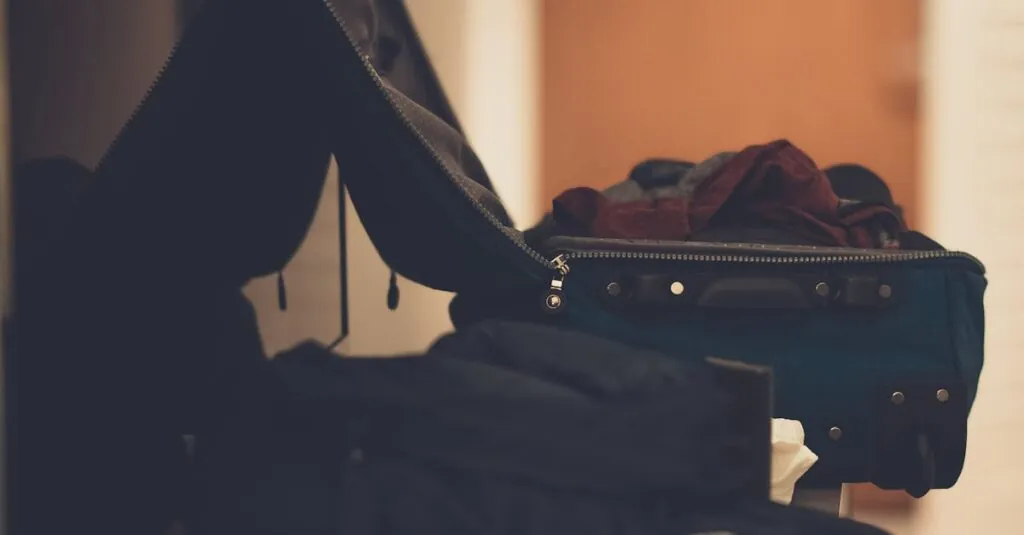Packing can feel like an Olympic sport—one minute you’re casually tossing clothes into a suitcase, and the next you’re wrestling with a stubborn zipper like it’s a grizzly bear. Whether it’s for a weekend getaway or a month-long adventure, mastering the art of packing can save time, space, and sanity.
Overview of Packing
Packing involves organizing belongings efficiently for travel. Mastering this skill can significantly enhance the travel experience. Packing also requires understanding the type of trip planned, whether it’s short or lengthy. Specific items play a crucial role in meeting various needs.
Packing strategies help reduce the hassle associated with managing luggage. Utilizing compact packing solutions keeps items organized and saves space. Clothes and accessories often require strategic placement for balance and accessibility. Choose versatile clothing that can adapt to different settings.
Travelers benefit from categorizing items into essentials, clothing, and toiletries. Toiletries should be packed in leak-proof containers to prevent mess. Important documents like passports and tickets deserve a designated spot for easy access. Knowledge of luggage weight restrictions aids in avoiding extra fees.
Utilizing packing cubes can streamline organization. Compression bags significantly reduce the volume of clothing, allowing for more room. Roll clothing to minimize wrinkles and maximize space. Items can be layered thoughtfully for efficiency and convenience.
Packing for a trip also includes preparing for unexpected situations. Include a small first aid kit and emergency snacks. Heeding climate conditions and itineraries guides appropriate packing choices. Researching destinations beforehand informs what to bring.
Prioritizing packing skills can transform stressful trips into enjoyable ones. Efficient packing not only saves time but also enhances overall travel efficiency. Each item packed should contribute to a seamless travel experience. Aim for practicality and flexibility, allowing for spontaneous adventures or changes.
Types of Packing Materials
Packing materials play a crucial role in protecting belongings during transport. Various options are available to suit different needs and items.
Boxes and Cartons
Boxes and cartons provide sturdy containers ideal for organizing and protecting items. They come in various sizes to accommodate different belongings, from clothing to fragile items. Cardboard boxes offer a lightweight solution, while plastic bins provide extra durability. Many manufacturers design boxes specifically for moving or shipping, ensuring they withstand handling. Consider using recycled materials to promote sustainability.
Bubble Wrap and Packing Peanuts
Bubble wrap and packing peanuts serve as effective cushioning materials for fragile items. Bubble wrap protects breakables with air-filled pockets that absorb shocks during transit. Packing peanuts, typically made from polystyrene or biodegradable materials, fill empty spaces and prevent shifting. These materials help maintain the integrity of items in transit, minimizing the risk of damage. Both options are lightweight, keeping shipping costs low.
Tape and Adhesives
Tape and adhesives secure packing materials and ensure boxes remain closed during transit. Packing tape offers a strong bond, preventing boxes from opening unexpectedly. Some people prefer using double-sided tape for a cleaner appearance. Sealable adhesive strips provide a handy option for certain packaging scenarios. Selecting the right tape or adhesive enhances the overall packing process and safeguards belongings.
Packing Techniques
Mastering packing techniques enhances organization and reduces stress. Effective strategies streamline the packing process for any trip.
Organizing Your Items
Categorizing items simplifies packing. Essentials such as medications and important documents should stay accessible. Group clothing into categories like tops, bottoms, and outerwear. Packing cubes keep similar items together, reducing clutter within the suitcase. Toiletries find a secure spot in leak-proof containers, minimizing the risk of spills. Shoes can be stored in separate bags to avoid dirtying clothing. Prioritizing organization allows for easier retrieval during travel.
Efficient Space Utilization
Maximizing suitcase space saves time and boosts packing efficiency. Rolling clothes instead of folding them creates space and minimizes wrinkles. Compression bags further condense bulkier items, freeing up room for other essentials. Filling shoes with small items, like socks, utilizes every inch of available space. Place heavier items at the bottom for balanced weight distribution, while keeping lighter items on top. Prioritizing efficient space utilization leads to a more enjoyable travel experience.
Common Packing Mistakes
Packing can easily devolve into a frustrating experience without careful planning. Awareness of common packing mistakes helps travelers ensure a smoother journey.
Overpacking vs. Underpacking
Overpacking occurs when travelers cram unnecessary items into their bags, leading to heavy and cumbersome luggage. Many assume a packed suitcase is better prepared for any situation. Overestimating needs can waste valuable space and complicate mobility. Underpacking, however, leads to forgetting essentials, resulting in last-minute purchases that may not align with personal preferences. Both scenarios create avoidable stress during travel. Achieving balance requires listing must-have items, considering the duration of the trip, and assessing the activities planned.
Neglecting Fragile Items
Fragile items often sustain damage during transit due to improper packing techniques. Travelers sometimes disregard the need for adequate cushioning and protective materials. Insufficient padding around delicate items increases the risk of breakage, leading to disappointment upon arrival. Utilizing bubble wrap or specialized boxes for glassware and electronics prevents significant damage. Securing these items ensures peace of mind while traveling. Travelers can reduce anxiety by visually inspecting fragile items before packing, allowing for a safer journey overall.
Mastering the art of packing can significantly enhance any travel experience. By adopting effective strategies and utilizing the right materials, travelers can minimize stress and maximize enjoyment. Prioritizing organization and efficiency not only saves time but also ensures that essentials are readily accessible.
With thoughtful preparation and a focus on versatility, packing transforms from a daunting task into a streamlined process. Embracing these techniques allows for spontaneous adventures while ensuring belongings arrive safely and intact. Ultimately, a well-packed suitcase sets the stage for memorable journeys ahead.













